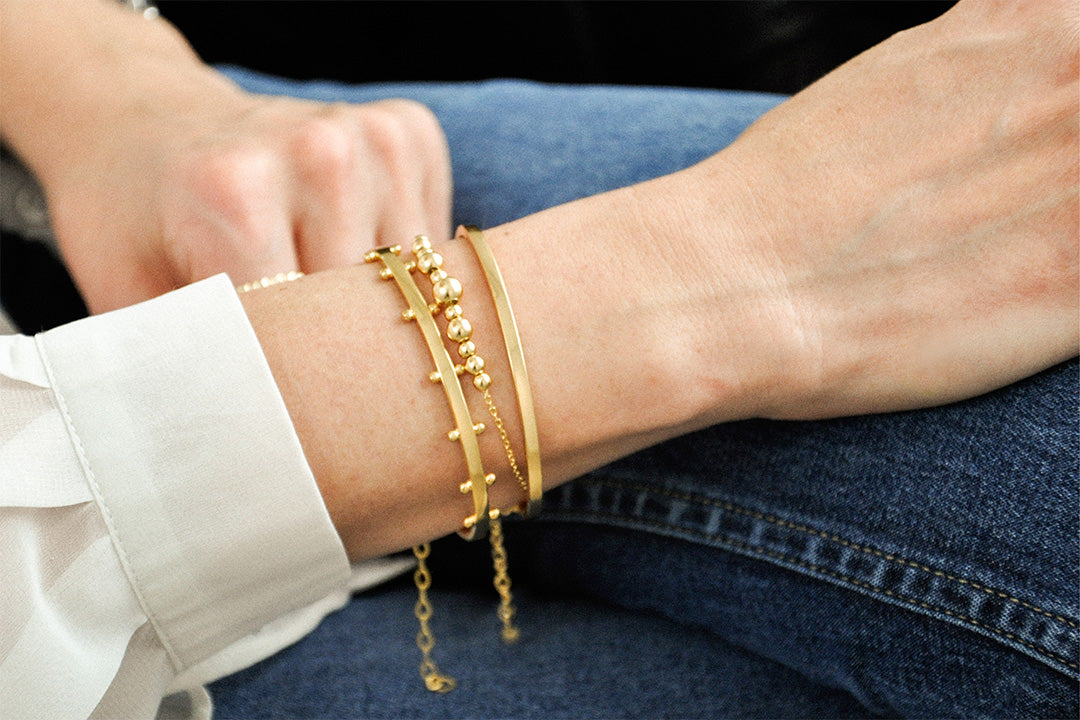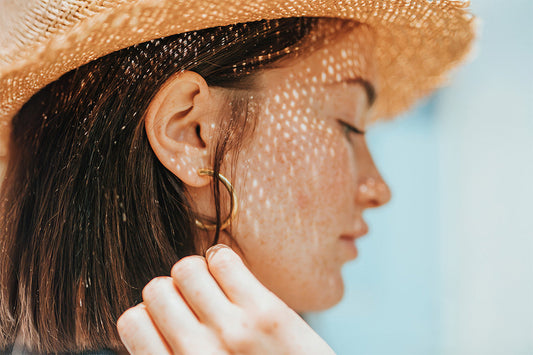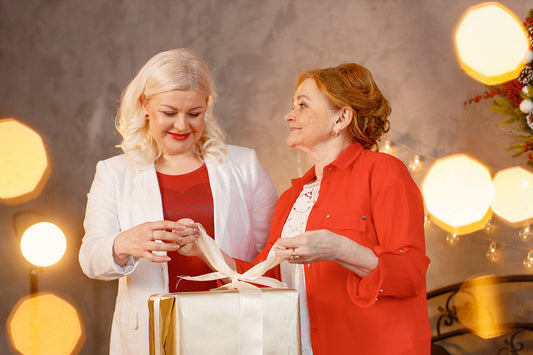
Does Gold Plated Jewelry Turn Green? Causes & Prevention
Gold plated jewelry offers the beauty and shine of real gold — but at a fraction of the cost. It’s a popular choice for those who love the look of gold without the high price tag. However, one common concern among jewelry lovers is whether gold plated pieces can turn green over time. Does it mean the jewelry is low quality? Will it affect your skin? In this guide, we’ll explore what gold plated jewelry really is, why it might discolor or react with your skin, and how you can keep it looking radiant and new for longer.
Table of Content
What Is Gold Plated Jewelry?
How Is Gold Plated Jewelry Made?
Gold plated jewelry is made by coating a base metal — usually brass, copper, or stainless steel — with a thin layer of real gold. This is done through a process called electroplating, where a tiny amount of gold is electrically bonded to the surface of the base metal. The layer of gold can vary in thickness, but most fashion jewelry has just 0.5 to 2.5 microns of gold — much thinner than gold-filled or solid gold pieces.
Because the layer is so thin, the base metal underneath can sometimes affect the appearance or behavior of the piece over time, especially if it’s exposed to moisture, friction, or skin oils.

Gold Plated vs. Gold Filled vs. Solid Gold
It’s easy to confuse gold plated jewelry with other gold-like options, so here’s a quick comparison:
Gold Plated: A very thin layer of gold over a base metal. Affordable, but less durable.
Gold Filled: A thicker layer of gold that’s mechanically bonded to the base metal. More resistant to tarnish, and typically longer-lasting.
Solid Gold: Pure or alloyed gold through and through. The most durable and valuable — and also the most expensive.
Gold plated jewelry gives you the look of gold without the price tag, but it also requires more care and attention if you want to maintain its shine and avoid discoloration.

Can Gold Plated Jewelry Turn Green?
The Science Behind Green Discoloration
Gold plated jewelry can sometimes cause green discoloration — but the likelihood depends greatly on the materials used underneath the gold layer. In Mionza’s case, gold is plated over 925 sterling silver, which is a precious, non-reactive metal that is far less likely to cause irritation or oxidation compared to copper or brass.
However, over time and with frequent wear, even high-quality plating can slowly fade, especially if exposed to moisture, sweat, or perfumes. If the gold layer thins out significantly, the underlying silver may begin to tarnish slightly, though it rarely turns green. Green discoloration typically occurs with cheaper, copper-based jewelry — not with well-made gold over sterling silver pieces.
Does Gold Plating Quality Affect This?
Yes — the thickness and craftsmanship of the plating make a major difference. Mionza’s gold-plated jewelry features a durable layer of gold over sterling silver, offering the aesthetic of solid gold with more longevity than typical costume jewelry.
Thicker plating (measured in microns) provides better protection for the silver base and helps prevent tarnishing or color transfer. Additionally, silver is much less likely to react with your skin or the environment. So, while no plated piece lasts forever, high-quality gold over silver offers significantly better resistance to green marks compared to lower-end alternatives.
Why Does Gold Plated Jewelry Sometimes Turn Your Skin Green?
Body Chemistry and Skin pH Levels
Even with high-quality materials like gold-plated sterling silver, your individual body chemistry can play a role in how your jewelry behaves. People with more acidic skin (lower pH) are more likely to experience mild reactions with metals — even precious ones like silver. This acidity can cause faster breakdown of the gold layer, especially in high-friction areas like fingers, neck, or wrists.
Additionally, factors like diet, medications, and stress levels can influence skin pH and perspiration. If your sweat contains more salt or acidity, it may interact more with the jewelry and accelerate discoloration. This is not a sign of poor quality — it’s simply how certain bodies react to certain materials.

Environmental Factors: Sweat, Water, and Air
External factors can also contribute to green staining or fading. Wearing your jewelry while exercising, swimming, or even during hot summer days can expose it to sweat, water, and humidity, which can speed up the natural wear of gold plating.
In particular, chlorine from pools, saltwater, and beauty products like perfumes or lotions can react with the metal and break down the gold layer faster. Over time, this may expose the silver base — which can tarnish if not properly cared for — and lead to minor skin discoloration in rare cases.
The good news? With proper care and awareness, these effects can be minimized or even prevented entirely. (We’ll cover that in the next section!)
How to Prevent Gold Plated Jewelry from Turning Green
Daily Care Tips to Keep It Looking New
The best way to prevent gold plated jewelry from turning green — or showing any signs of wear — is to build a simple care routine. First and foremost, avoid contact with water, sweat, and harsh chemicals. Always remove your jewelry before showering, working out, or applying products like perfume, lotion, or sunscreen.
When you’re done wearing your pieces for the day, gently wipe them with a soft, dry cloth to remove any oils or moisture. This small habit helps preserve the gold layer and keeps your jewelry looking shiny and new for longer. Also, try to rotate your jewelry instead of wearing the same piece every day — this minimizes friction and extends its life.

Best Storage Practices for Longevity
Proper storage is just as important as daily care. To protect the gold plating and prevent tarnishing of the silver base, keep your jewelry in a dry, airtight container when not in use. Jewelry boxes with anti-tarnish lining, small zip bags, or soft cloth pouches work great. If possible, store each piece separately to avoid scratches.
You can also place a silica gel packet or anti-tarnish strip in your storage area to absorb moisture. Avoid leaving your jewelry in the bathroom or anywhere with high humidity — it accelerates the breakdown of the plating.
By treating your jewelry with care, you're not only protecting its appearance — you're also preserving the meaning and value it carries for you.
How Long Does Gold Plated Jewelry Last Before It Changes?
Factors That Affect the Lifespan of Plating
The durability of gold plated jewelry depends on several key factors: the thickness of the gold layer, the quality of the base metal, how often it’s worn, and how well it’s cared for. Mionza’s pieces, for example, are plated over 925 sterling silver and built with longevity in mind — but even the best gold plating is still a surface treatment, not a permanent finish.
If you wear your piece occasionally and follow proper care routines, gold plating can stay beautiful for 1 to 3 years or more. However, daily wear, friction, exposure to moisture, and poor storage can shorten that lifespan significantly.

Signs It’s Time to Replace or Re-Plate
Over time, you may notice the color fading, a slightly dull appearance, or even a faint silver tone showing through — especially on high-contact areas like the back of a pendant or inside of a ring. These are natural signs of wear and don’t mean your jewelry is low quality.
When this happens, you have a few options:
Re-plating the piece through a jeweler can restore the original look.
Or you can continue wearing it as-is — many people love the mixed-metal look as it evolves over time.
The key takeaway? Gold plated jewelry is meant to be worn and enjoyed. With the right care, it can remain a cherished part of your collection for years to come.






